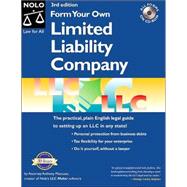This bestseller covers how to:
-- choose a valid LLC name
-- prepare and file Articles of Organization
-- set up a member-run or manager-run LLC
-- take care of ongoing legal and tax paperwork
The 3rd edition has been revised to reflect the latest federal regulations as well as each state's laws. Provides all necessary forms -- with instructions to fill them out -- as tear-outs and on CD-ROM.








